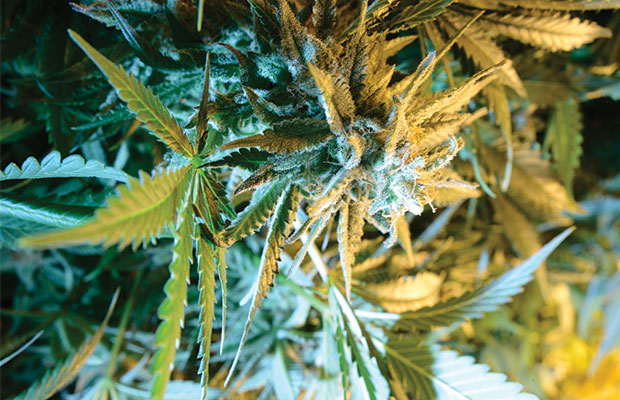
Economics
Q&A With Green Rush Founder/CEO Paul Warshaw
In essence, Green Rush has applied the food delivery service model to the cannabis industry — and it’s seeing early success.
The model of the cannabis delivery business is one that seems to take only one form: you sign up, get validated, browse a small menu online and then wait for cannabis to be delivered to you in the comfort of your own home.
But one delivery platform based in San Francisco has carved out a new business model that sets itself apart from the rest. Instead of delivering products from a random dispensary the user does not choose, Green Rush puts “the dispensary first,” as founder and CEO Paul Warshaw says. The Green Rush platform allows the patient to choose the exact dispensary and product they wish to receive, and which the dispensary itself then delivers.
Warshaw spoke to Cannabis Now before the Halloween weekend about what sets Green Rush apart from its competition, how his company plans to adapt to California’s rapidly shifting marketplace and why he dropped everything in New York to move to San Francisco.
You publicly launched Green Rush in April. How have these first six months been?
April 29th was our official launch date. We’ve been officially in market for five to six months now and we have 125 dispensaries currently actively using our platform and several thousand patients ordering on a regular basis.
Has this turnout been better than expected?
The process itself has moved a little faster than we anticipated. We didn’t expect to sign up as many partners so early. We still have a long road ahead, but it’s been a really successful opening.
How does the Green Rush platform work?
What happens is we partner with businesses that are already providing delivery services. A patient comes on to the platform and they sign up. It’s super simple: you upload a picture of your driver’s license and medical marijuana card. That info gets sent to the customer support through HIPAA compliant server. Once the patient is verified, they can freely order from any of the dispensaries on our platform. Their order is sent to the dispensaries, and then it’s their job to take the order, fill it and deliver it through their drivers. We do give dispensaries delivery logistics where they can track the driver. Our model is a different spin. We just want to build really good solutions for the cannabis industry.
Before Green Rush launched, you ran a beta test in a partnership with five dispensaries. What feedback did you get from the beta testing?
We provide a technology and a marketing platform, and we had the five dispensaries give us feedback on both angles. On the technology side, there was a level of excitement from dispensaries because we can streamline the process for them online, from patient verification through online ordering to delivery logistics. On the marketing end, the dispensaries liked how we are able to provide a full fleet of marking. A lot of dispensaries don’t have websites and don’t have places to actively advertise, so having a platform for them to enhance their business was the most exciting thing for most of them.
The field of marijuana delivery companies in the Bay Area and California is crowded, with Eaze, Meadow and Flow Kana, among others, already operating. What does Green Rush plan to do to set itself apart from the competition?
San Francisco has become a pretty crowded marketplace, but we have some key differentiators. We have the highest amount of partner dispensaries, which gives patients the most options. Other delivery services are pretty limited. Our goal is really to learn about our patients: what they like, what they buy and why. We want Green Rush to be similar to Amazon, where if you buy a flashlight, the platform is going to recommend you buy batteries next. On other platforms, you have to sift through menus by yourself and educate yourself. Also, we’re dispensary focused and a lot of our competition is product focused. If you wanted to order a pizza or pasta or salad, you’d want to know where it’s coming from. You choose the place first and then you select what you want to order from there. But some of our competitors will just bring you pizza from a place they’ve chosen. There’s more transparency with Green Rush.
Will this new delivery structure make your prices higher than other services?
We have something for everyone. We have a very diverse clientele. A huge percentage of our patients are cost conscious, and are looking for $35 dollar eighths and affordible concentrates. But on the flip side, we have professionals and moms at home who are focusing on quality. Our platform has a diverse patient base, and the product to match. We want to make sure that you’re aware of all your options. If you’re cost-conscious, we’re going to display the cheaper options first for you, so you don’t have to filter through the stuff you don’t want to buy.
The cannabis market in California is in a state of flux, after the passage of a new regulatory structure and the possibility of impending adult-use legalization in 2016. How does Green Rush plan to weather the storm of change?
We’re laser-focused on California currently. Our philosophy is we want to focus on one market, versus some other companies that are looking to touch multiple markets at one time. We’re looking to grab a significant market share here before we spread. About the regulation changes, we take a strong position that we’re a tech and marketing company first, who’s partnering with the best dispensaries in the market. Everyone we work with operates above board, from Harborside to the mom and pops. As the market shifts, we’re providing technology and marketing so we’re going to have an easier time pivoting along with the marketing.
Before you started Green Rush, you were working for an event marketing and ticketing business, BallDrop, in New York. What inspired you to drop everything in New York and start Green Rush in San Francisco?
I’ve been in technology and marketing for about 15 years. I started off my career in the entertainment space. I ran a digital group at Universal Music and worked on a bunch of online marketing projects, including the launch of Vevo. I left Universal and I pivoted into a different space. A couple of buddies and I started an event and ticketing company. It’s called BallDrop, and it is the largest producer of New Year’s Eve events in the country. I worked in it for five years, but it was an extremely seasonal business. I was only busy a couple of months a year, so I was looking for a new project. I have a friend who is a real estate developer in the cannabis space who encouraged us to go to Colorado and California, because he said my technology, marketing and customer acquisition skills could add tremendous value to the industry. At first, I didn’t think the cannabis industry was for me. I’m enthusiastic about the plant itself, but I was hesitant about the industry. But as I spent time in Denver and San Francisco and got educated in the industry and as I visited retailers and head shops and dispensaries, I figured I could build a useful platform for the industry. That’s how the business was born about 18 months ago. When I heard cannabis, I was uneducated so I spent a year learning about the industry. I fell in love and dropped everything in New York and moved to San Francisco.
What is it like being based in the Bay Area?
The evolution of the industry over the last 12 months has been pretty intense. When we first started, there was a lot less action and not as many traditional mainstream people involved, but over the last year everyone of from investors, marketers, publicists and tech people have jumped in the space. It’s been really amazing to be part of the culture. For the people who’ve been in it for 25 years, it must be crazy. I have friends who wear suits every day, real Wall Street types, are now starting to look at the cannabis industry. It’s been cool watching the industry rip itself out of the stereotype of the stoner world and validate itself as legitimate.
As Green Rush moves forward in this new era of the mainstream cannabis industry, are there any projects or developments on the horizon that you’re excited about?
I think for now we’re really focused on building a fantastic experience for patients and for dispensaries. It’s just taking feedback and continuing to evolve and grow the product. In terms of marketing, we just launched our ambassador program, and we’re working with cannabis enthusiasts and people passionate about the cannabis industry to go out and promote Green Rush to patients. We’re also looking forward to the potential of California adopting recreational rules next year. There’s a huge market of people out here that would love our service but don’t have cards. The opportunity really amplifies for us once the recreational rules get passed, which we’re hoping will happen next year. It’s a game changer for us, because that’s a market of 38 million people, not a couple million. The size will grow up to 10 times.


























